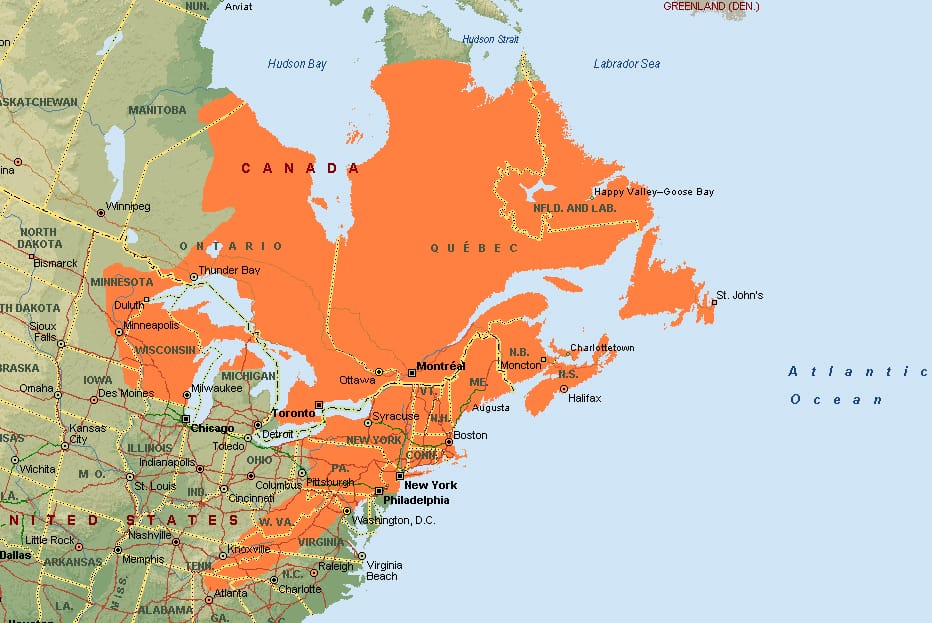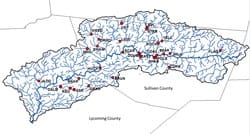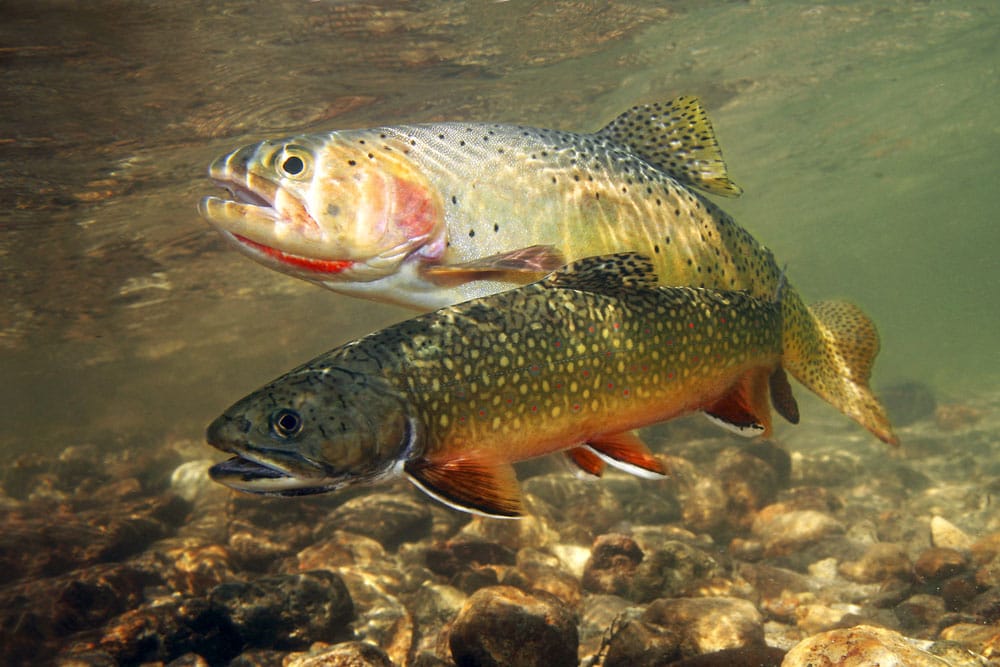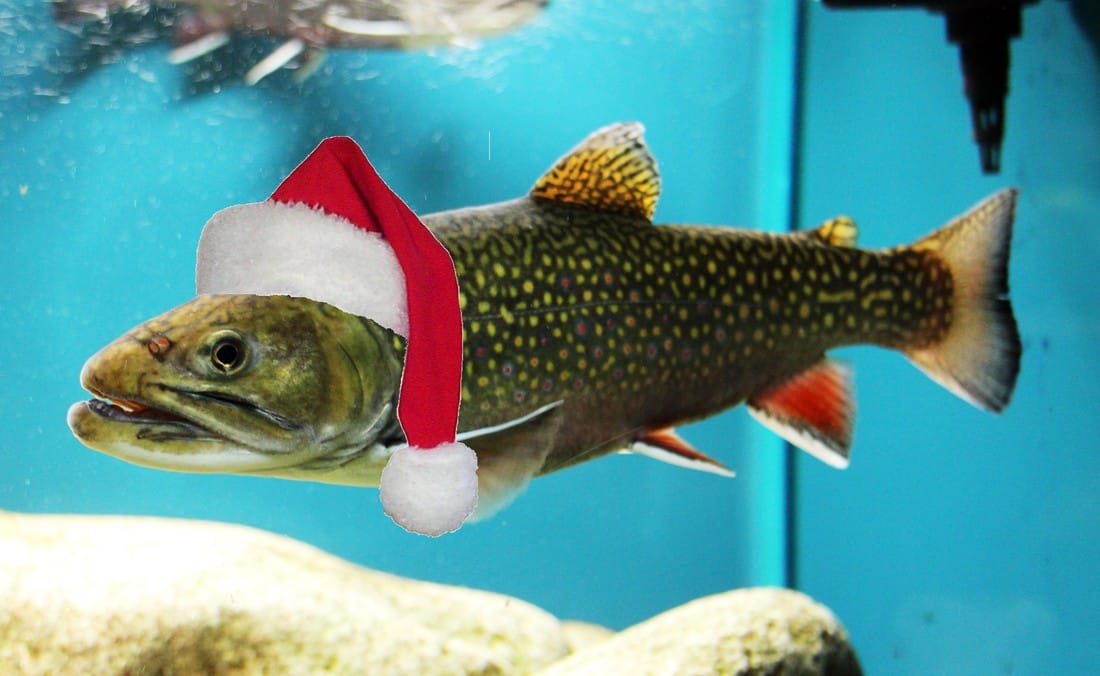 The native range of brook trout shown in orange. How do you manage a species that covers multiple states and countries? The native range of brook trout shown in orange. How do you manage a species that covers multiple states and countries? ^ Pun intended Last week we talked about how genetics can aid in the management of threated fish species by quantifying genetic diversity (remember, the more the better) and identifying isolated populations (again, recall that population isolation is usually bad, but read last week’s post for a contrary example). But, genetic studies can be important for management of even the most common fish species by helping identify the right scale of conservation and management efforts. What does ‘scale of management efforts’ mean? Let’s think about brook trout. Though sometimes locally common, brook trout is a species of considerable concern throughout its native range extending from Maine to Georgia. In just about every state on the east coast fisheries managers are tasked with creating a management plan that accomplishes two fundamental goals: secure long-term population persistence in the face of climate change, invasive species, and habitat loss AND increase angling opportunities. If those goals seem in opposition, welcome to fisheries management. Conservation and recreation sometimes don’t go hand in hand. But, I digress… So, plans are created. But, how much area should each plan cover? The entire range of brook trout? It is, after all, the same species. But, that doesn’t really make sense. Threats to brook trout are different in Maine than they are in Georgia (Georgia is a lot hotter, for starters). Plus, different states receive funding from different locations, have different levels of involvement from citizen groups, and have different levels of angling pressure. So, to make one really big management plan that encompasses the entire range of brook trout and all possible threats would not be very usable to local managers. Plus,depending on who you talk to, some believe brook trout are actually multiple species along the east coast. So, it needs to be more fine-tuned that than. What about a brook trout management plan unique to each state? This gets closer. Across a state you would expect climate-related threats to be reasonably similar and funding sources to be shared within state boundaries. But, this scale is also problematic. Streams can cross state boundaries, there’s different interest in cold and warmwater fisheries across the state, and land use (and threats related to changes to land use) are different across the state. So, we still need something smaller. Okay, how about a management plan for every individual stream? While this would definitely provide a lot of protection to localized threats, it is only practical for the largest streams and rivers. Biologists haven’t even surveyed many small headwaters, so we don’t know if they contain brook trout, or what the threats may be. So, to inventory the threats and population sizes of each stream and then create and implement a plan of action is not possible. Even if we did make those plans, a single fisheries manager is often tasked with covering a large chunk of the state and so they couldn’t possibly enforce a management plan that is unique to each and every stream. Further, it compartmentalizes individual streams when we need to focus on connectivity between waterways.  Every red dot on this map is a population in my genetics study. While data analysis is ongoing, we suspect each population will be genetically distinct from one another. Every red dot on this map is a population in my genetics study. While data analysis is ongoing, we suspect each population will be genetically distinct from one another. So, what is the solution? The truth is there’s often no easy answer, and it often depends on the ecology of the species. A highly mobile fish can, and should, be managed at larger scales than a smaller fish that moves shorter distances. But, there are trade-offs. At larger scales you may miss some of the local problems, and at smaller scales you may be unable to manage the entire range of the species effectively and not pay attention to process that happen at larger scales. But, for most species and for many managers, the easiest balance of scales is found at the unit of a watershed. And, ‘watershed’ can be somewhat ambiguous because every small stream has its own watershed. But, when I say watershed, I generally mean the area of land that is drained by a reasonably large river. Larger watersheds represent an area of land that is easy to identify and has similar threats and recreational uses. Further, species composition within a watershed is likely to vary little, such that a watershed with brook trout is unlikely to also be a trophy largemouth bass fishery (because largemouth are a warmwater species). But, while watersheds can make the most practical sense, are they biologically the most appropriate? For highly mobile species, they probably are. However, while brook trout are mobile, we also know that populations tend to quickly become genetically distinct. Several studies have found that brook trout populations from neighboring streams often show genetic separation, even in the absence of a barrier. This would indicate to us that nearly every stream in a brook trout watershed is its own independent unit. And, if you’re following my studies in Loyalsock Creek, preliminary results suggest that every population that I sampled is genetically distinct from one another. So, should we let genes dictate our management efforts and manage each genetically distinct population? Maybe, but, again, it really isn’t feasible and perhaps not necessary. But, what we can do is factor that information into our watershed’s management plan. As we learned from our last post, being genetically distinct isn’t a guarantee that the population is completely isolated, or at risk of collapse. It just means there are not that many fish moving in and out of the population. And, we are quantifying genetic similarity from microsatellites, which are neutral genetic markers and therefor do not suggest that there are specific, important genes absent or present in some populations. So, there’s no reason to suggest that genetic distinction is indicative of reduced long-term survival (there are other metrics we need to look at to start making inferences about how genetically “safe” a population is…a post for later). So what does it tell us? The fact that populations are genetically distinct could suggest that brook trout are locally adapting to the environment at small spatial scales. In the future, hatchery stocking and translocations from one population to another are going to become increasingly popular tools for managing brook trout However, stocking populations that are genetically incompatible with the environment can either cause immediate mortality or lead to outbreeding depression, which occurs when a native individual mates with a foreign (be it stocked or a migrant) individual, and the resulting offspring have genotypes that make them maladapted to local conditions. So, considering local adaptation is necessary for ensuring successful management outcomes. The fact that even neighboring populations of brook trout are prone to becoming genetically distinct also highlights the importance of maintaining connectivity. The reality is that few trout move, and then reproduce, outside their native streams. But, in this case, the minority of the population takes high priority. It may not result in two populations becoming genetically similarit, but the handful of trout that do move and reproduce elsewhere are increasing genetic diversity at the new site. Ultimately, increased genetic diversity is what we want to see as it increasing resilience to habitat loss. It’s nature’s own management plan! So, for brook trout, we can’t let genetics decide our management scale, but we can use it to improve our management practices and help us better understand the ecology of the species. This may be my last post of 2016, so next time we'll take a look back at the year that was. Until then, I think I need to watch Home Alone for the upteenth time. Happy holidays to all!
5 Comments
7/16/2017 10:29:29 pm
Hi to everybody, here everyone is sharing such knowledge, so it’s fastidious to see this site, and I used to visit this blog daily
Reply
9/20/2017 03:55:12 am
Opting to study business and finance is a considerable step to take for all potential undergraduates. Whatever your career intentions, it is vital that you choose a degree programme that equips you with the key skills required to maximise those prospects.
Reply
nonefitria
12/27/2017 04:25:54 pm
<a href="https://obatpembesarpenis-id.com"> obat pembesar alat vital laki laki</a>
Reply
3/9/2020 02:45:12 am
This medication is available by prescription only. It is possible to buy Viagra in pharmacies, provided you obtain a prescription from your doctor
Reply
Leave a Reply. |
AuthorShannon White Archives
October 2018
Categories
All
|
The Troutlook
A brook trout Blog
Proudly powered by Weebly


 RSS Feed
RSS Feed